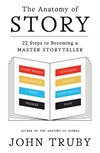E D Skinner
Storytelling Frameworks for Business Applications
Exploration of various storytelling frameworks, including Vogler’s Hero’s Journey and others, highlighting their context and business applications for effective communication in creative and corporate environments.
betterstories.org
